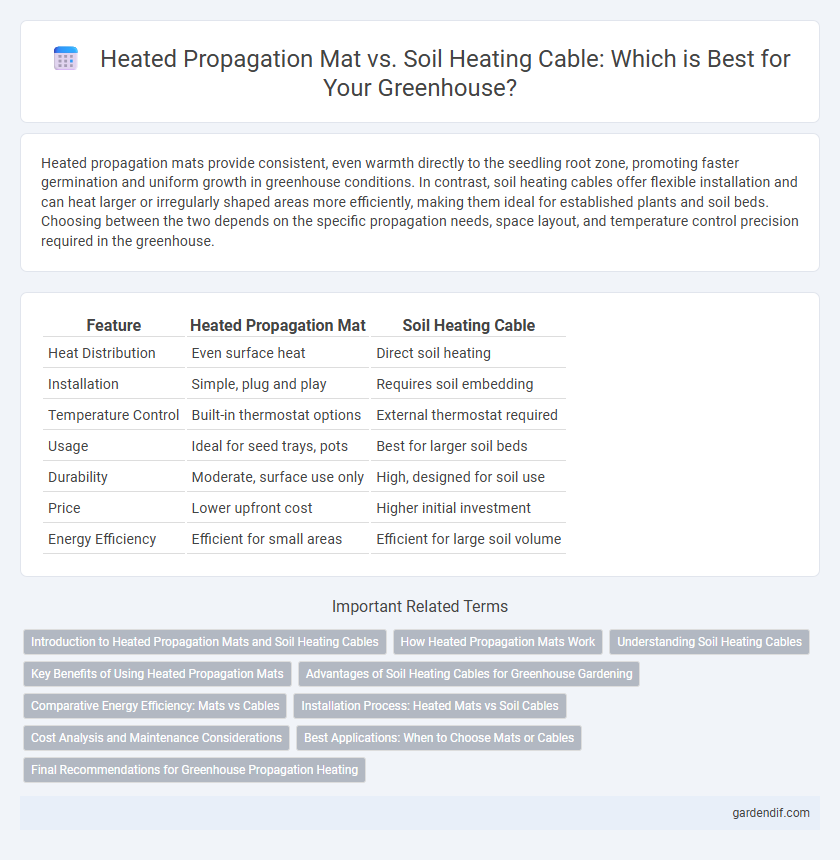
Heated Propagation Mat vs Soil Heating Cable Illustration
Heated propagation mats provide consistent, even warmth directly to the seedling root zone, promoting faster germination and uniform growth in greenhouse conditions. In contrast, soil heating cables offer flexible installation and can heat larger or irregularly shaped areas more efficiently, making them ideal for established plants and soil beds. Choosing between the two depends on the specific propagation needs, space layout, and temperature control precision required in the greenhouse.
Table of Comparison
| Feature | Heated Propagation Mat | Soil Heating Cable |
|---|---|---|
| Heat Distribution | Even surface heat | Direct soil heating |
| Installation | Simple, plug and play | Requires soil embedding |
| Temperature Control | Built-in thermostat options | External thermostat required |
| Usage | Ideal for seed trays, pots | Best for larger soil beds |
| Durability | Moderate, surface use only | High, designed for soil use |
| Price | Lower upfront cost | Higher initial investment |
| Energy Efficiency | Efficient for small areas | Efficient for large soil volume |
Introduction to Heated Propagation Mats and Soil Heating Cables
Heated propagation mats provide consistent, gentle warmth to seedlings by evenly distributing heat across the soil surface, promoting faster germination and strong root development. Soil heating cables, embedded directly into the soil, deliver targeted heat at adjustable depths, making them ideal for deeper root zone warming in greenhouse environments. Both solutions enhance plant growth by maintaining optimal soil temperatures, but mats are often preferred for surface warmth, while cables suit more controlled, subsurface heating needs.
How Heated Propagation Mats Work
Heated propagation mats use embedded electric heating elements to provide consistent warmth directly beneath seed trays, promoting optimal root development and faster germination in greenhouse settings. They maintain a stable soil temperature by evenly distributing heat through their insulated surface, preventing cold spots that can slow plant growth. Unlike soil heating cables that are buried in the soil, propagation mats offer uniform heat distribution without disturbing the seedbed, making them ideal for delicate seedlings and cuttings.
Understanding Soil Heating Cables
Soil heating cables provide consistent and uniform heat distribution directly to the soil, promoting optimal root development and seed germination in greenhouse environments. Unlike heated propagation mats which warm from the surface, soil heating cables are embedded within the soil, allowing precise temperature control and energy efficiency. This targeted heating method helps maintain ideal soil temperatures, improving plant growth and reducing the risk of fungal diseases caused by excessive surface moisture.
Key Benefits of Using Heated Propagation Mats
Heated propagation mats provide consistent and uniform warmth directly to seed trays, promoting faster germination and stronger root development compared to soil heating cables, which can have uneven heat distribution. These mats are energy-efficient and easy to use, offering precise temperature control that minimizes the risk of overheating delicate seedlings. Their compact design and portability make them ideal for any greenhouse setup, improving propagation success rates while saving space.
Advantages of Soil Heating Cables for Greenhouse Gardening
Soil heating cables provide consistent, flexible heat distribution directly within the soil, promoting uniform root development and faster seed germination in greenhouse gardening. Their adjustable length and durability allow customization for various bed sizes and shapes, optimizing energy efficiency compared to heated propagation mats. Improved moisture retention and prevention of surface overheating contribute to healthier plant growth and reduced risk of fungal diseases.
Comparative Energy Efficiency: Mats vs Cables
Heated propagation mats provide consistent, evenly distributed warmth directly to seed trays, resulting in lower overall energy consumption compared to soil heating cables, which often require higher power to achieve similar temperature levels. Propagation mats typically operate at lower wattage and deliver uniform heat, reducing energy waste caused by heat loss or uneven soil warming commonly seen with cables. Energy efficiency gains with mats translate to cost savings and enhanced seed germination rates due to stable root zone temperatures.
Installation Process: Heated Mats vs Soil Cables
Heated propagation mats offer a straightforward installation process, simply placing the mat beneath seed trays or pots for even heat distribution without complex setup. Soil heating cables require careful burial within the soil or propagation medium, ensuring proper spacing and depth to avoid hotspots and promote uniform warmth. While heated mats are plug-and-play and ideal for small-scale use, soil heating cables suit larger greenhouse beds but demand more expertise during installation.
Cost Analysis and Maintenance Considerations
Heated propagation mats generally offer a lower upfront cost and simpler installation compared to soil heating cables, making them an economical choice for small-scale greenhouse propagation. Soil heating cables provide more precise and uniform soil temperature control, but often require higher initial investment and occasional replacement due to wear and tear. Maintenance for propagation mats is minimal, involving basic cleaning and careful handling, whereas soil heating cables demand regular inspection for damage and potential electrical issues to ensure consistent performance.
Best Applications: When to Choose Mats or Cables
Heated propagation mats are best for seed germination and delicate seedlings, providing uniform warmth directly beneath trays for consistent root zone temperature. Soil heating cables excel in larger greenhouse beds requiring deep, customizable heat distribution, ideal for root development in established plants. Choose mats for small-scale propagation and cables for scalable, targeted heat in diverse soil conditions.
Final Recommendations for Greenhouse Propagation Heating
Heated propagation mats provide consistent, uniform warmth ideal for seed germination and root development in greenhouse environments, while soil heating cables offer more flexible placement and deeper soil penetration suitable for established plants. For small-scale propagation, heated mats are cost-effective and easy to use, whereas soil heating cables suit larger, customizable setups requiring precise soil temperature control. Ultimately, greenhouse growers should select heated mats for uniform, surface-level warmth during early growth and soil cables for targeted, deeper heat in advanced propagation stages.
Heated Propagation Mat vs Soil Heating Cable Infographic

 gardendif.com
gardendif.com